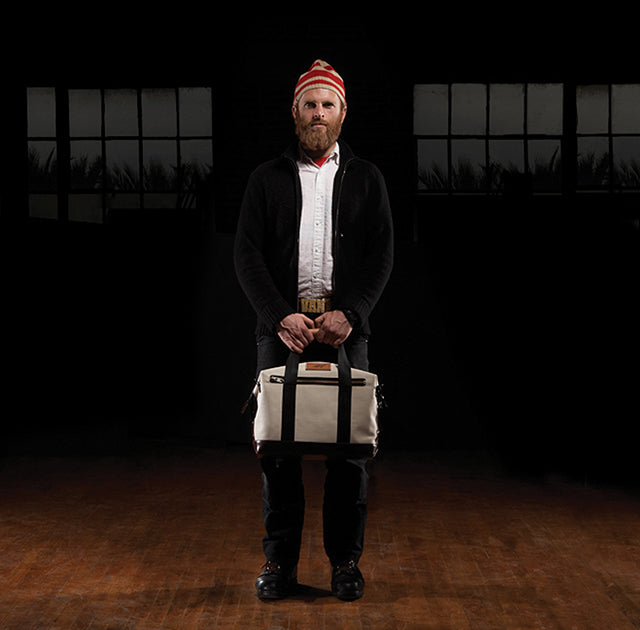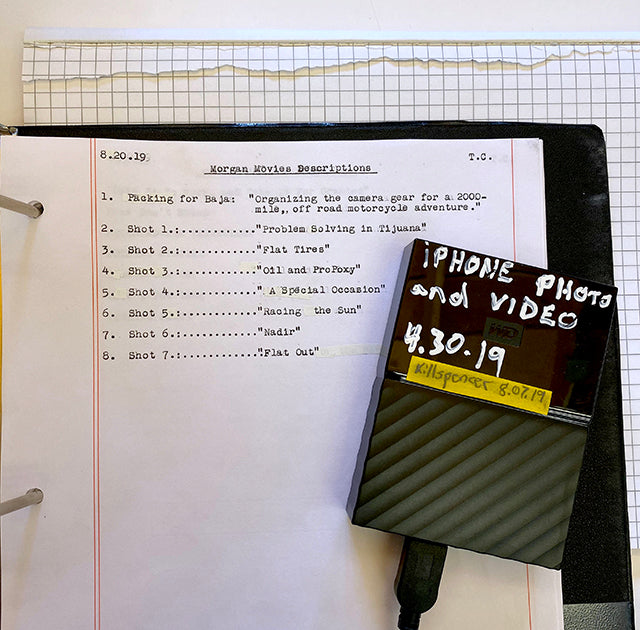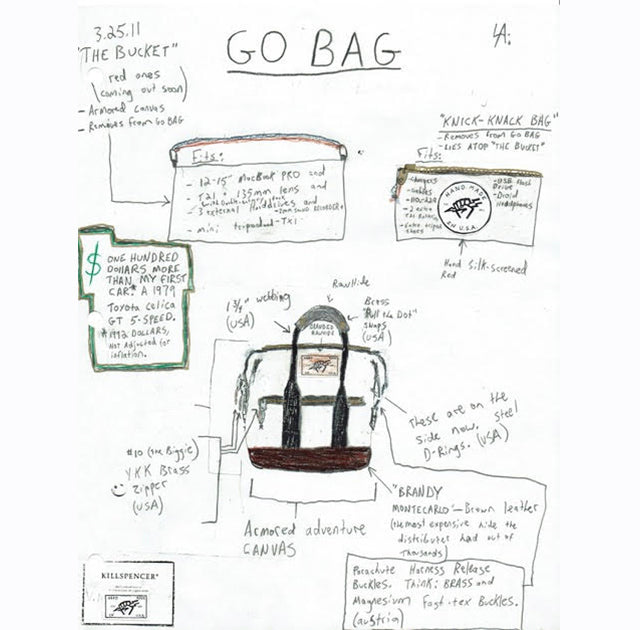THE EVOLUTION OF THE CW MORGAN BAG
It was okay, but I had to undo two belt buckles to open it, and there wasn’t any padding for my sensitive little digital instruments. Eventually, the handles tore out from the canvas part.
I wanted a tool bag--but for cameras--and one did not exist.
Not a backpack for cameras. Not a purse for cameras. Not a fanny pack for cameras. Not a messenger bag for cameras. A tool bag. Open it, do your work, fish things out, toss things in, grab it real quick, and jump over here to wrench on this other thing. Throw it--throw it--into the truck cab. But for cameras. Expensive, fragile, dust-free cameras.
I designed this bag with Spencer back in 2011, and for the last 8 years, she’s been my inseparable buddy. We’ve been across the USA, overland, 3 or 4 times; up and down the Baja Peninsula, off-road on a dirt-bike; 9000 round-trip miles from the Bronx to Oaxaca in a Ford pickup; Old Europe; Japan twice; Indonesia; and mandatory wildfire evacuated from our home in Topanga Canyon, California. She’s tough, like a tool bag, but soft and cozy on the inside, protecting, expensive, fragile film making instruments from their broodish and clumsy owner.
I have learned that repairability is a mark of quality, and that reliability trumps all. My truck is a 32-year-old diesel, and my typewriter is a 1936 manual. Any competent shoe repair shop can fix this bag in the unlikely event that it breaks. Back in 2014, I managed to bust a couple zipper teeth by using all my strength to zip her shut overloaded. I brought her to a shoeman in Zihuatanejo, Mexico and he put in a new zipper for about eight dollars American. Spencer has kindly offered to replace the Mexican zipper with a stock, OEM, YKK #10. Thanks, Mate, I’ll take you up on that. Also, I tore some micro-holes in the canvas somehow, but stitched them up myself with needle and thread.
Spencer has suggested I replace my 2011 Morgan bag, with a clean, brand-new one, but I told him he’ll have to take the 2011 “from my cold, dead hand.”
She’s called the CHARLES W. MORGAN bag after an old whaling ship that’s harbored near the town where I grew up. Launched in 1841, the Morgan is the last of her kind, and remains sea-worthy to this day, though no longer used for whale-hunting. The Morgan bag even resembles her namesake rigged in sails of canvas.
The Morgan bag is my under-the-seat personal item, containing all the gear I absolutely cannot lose under any circumstances. She’s fast through security, my laptop slides in and out real quick.
Fully-loaded, she weighs in at about 25 pounds. I improvised a shoulder strap out of a flat-stock bungee cord that sort of synchronizes the bag’s bounce with your footsteps, and somehow, probably because of science, absorbs the energy that normally gets transferred right into your trapezius. I had to zip-tie the bungee cord to the bag’s d-rings so it wouldn’t fall off, but Spencer has whipped us up a strap with gorgeous, USA-made carabiner-type buckles that I can’t wait to try out.
I think the crowning achievement, vis-a-vis functionality, of the Morgan bag is the camera “bucket” that slides in and out with the aid of an “Old Glory” strap. On set, I pull out the bucket, and use the empty Morgan bag to store my jacket, books, and candy. Sometimes we want to haul around other stuff besides our camera gear, but we don’t have the heart to leave our gear homeless. The bucket is a nice little storage facility during down-time. Both the bag and the bucket are insulated with some kind of space-age NASA foam that doesn’t compress over time--certainly not over the course of 8-years-and-counting-- so’s you don’t crack your LCD-screened gadgets. I regularly bungee the Morgan bag to my motorcycle luggage rack, with maybe 20 lbs or more of tension, and I’ve not yet broken a screen, knock on wood.
The little knick-knack bag is sort of a junk-drawer for all my chargers and cords and adapters and rubber bands.
Looking at my Morgan bag right now, in my studio, it occurs to me that I don’t unpack it when I’m home. When I’m back from the road, I mean. My vitals live in that bag. That’s where they go. If I need to stamp to mail a letter from my mailbox, it’s in the zip-pocket of my Morgan bag. It’s like a little house inside my house.
When we designed and built this bag, we knew it was going to be really expensive. Maybe the expensive camera bag in it’s class. I also knew that folks who could not afford it would buy it anyway, because I’ve been broke too, and bought gear I couldn’t afford. Some among us have a professional mindset, and, flush or flat, a pro don’t skimp.
--Van Neistat, journeyman filmmaker
ABOUT VAN NEISTAT
Van Neistat is a filmmaker who lives in New York City and Los Angeles. A pioneer in digital filmmaking, Neistat made his first internet video, The Holland Tunnel, in 2000. A 3-minute short, starring, written and shot by Neistat, The Holland Tunnel was featured on Japanese Television as well as in film festivals around the world. The video featured Neistat riding his bicycle—in less than 5 minutes—through a 35-minute traffic jam in New York City’s Holland Tunnel.
With his brother Casey Neistat in 2003, Neistat co-wrote and co-directed iPod’s Dirty Secret, a 2-minute video about Apple’s iPod battery policy. The short received millions of views (pre-YouTube) and broke a national news story, leading to Apple’s defeat in a $175 million class-action lawsuit.
Also in 2003 Van Neistat collaborated with New York City artist Tom Sachs, directing a series of short films shown at the Guggenheim Museum in Berlin.
Neistat went on to write and direct more short films with his brother Casey and the two were the youngest artists featured in the 2004 Sao Paolo Biennal. His short films have been shown in museums all over the world.
In 2010 HBO aired The Neistat Brothers, an 8-episode series of short videos made entirely by Van and Casey Neistat. Also in 2010, Van Neistat directed the short film series 10 BULLETS, co-written by Tom Sachs and John Ferguson. 10 BULLETS was subsequently used by NASA’s Jet Propulsion Laboratory as an unofficial training video for new employees.
Van Neistat’s directorial debut feature, A SPACE PROGRAM, premiered at the 2015 South by Southwest Film Festival and opened in theaters nation-wide in spring, 2016. A SPACE PROGRAM received 4 1/2 stars in the Guardian and also earned good reviews in the Village Voice, Variety, LA Times and New York Times.
He has written and directed commercial projects for Sleepy Jones, Kate Spade, Frances Valentine, Tory Burch, J. Crew, Hurley, and Nike.
--
Films by Van Neistat @vanneistat












Leave a comment